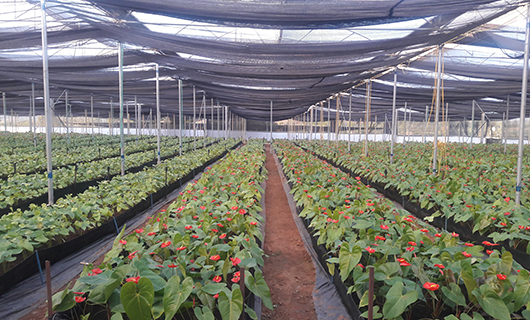Different Types of Knitted Shade Net and Their Uses

When protecting plants and crops from harsh weather conditions, such as excessive sunlight, heat, or wind, shade nets are handy. These nets offer an effective way to control the intensity of sunlight and temperature for better plant growth and yield. The material of these shade nets could vary, but one of the most popular ones is knitted shade netting. This article will discuss the different types of knitted shade net and their uses.
Monofilament Knitted Shade Net
Monofilament knitted shade netting is made of high-density polyethylene (HDPE) and is characterized by its sturdy, robust construction. The netting is highly resistant to UV rays and can protect plants from the sun’s harsh glare, making it perfect for greenhouse farming, shade houses, and nurseries. This type of shade netting comes in varying densities, such as 30%, 40%, 50%, 60%, 70%, and 80%, allowing you to choose the proper density for your needs.
Tape Knitted Shade Net
Tape-knitted shade netting is made of flat tape and has a unique construction that makes it more tear-resistant than other knitted shade netting. It makes it perfect for use in windy areas. The netting is available in varying densities and colours, such as green, black, and white, making it suitable for various applications such as car parking shades, swimming pool shades, and outdoor events.
Raschel Knitted Shade Net
Raschel knitted shade netting is made of HDPE, making it highly durable and resistant to UV rays. This type of shade netting comes in different densities, such as 35%, 50%, and 70%, and is perfect for use in agricultural and horticultural settings. The netting is available in various colors, including green and black, and can be used for crop protection, greenhouse farming, and shade houses.
Anti-Hail Knitted Shade Net
Anti-hail knitted shade netting is a specialized type of knitted shade netting that is designed to protect crops from hail damage. The netting is made of HDPE and is highly resistant to UV rays. It comes in varying densities, such as 30%, 40%, 50%, and 70%, and can be used for crop protection, greenhouse farming, and nurseries. Anti-hail knitted shade netting is available in green and white colors.
Flame Retardant Knitted Shade Net
Flame retardant knitted shade netting is made of HDPE and is designed to resist flames, making it perfect for use in areas where fire safety is a concern. The netting is available in varying densities, such as 30%, 50%, and 80%, and comes in green and black colors. Flame retardant knitted shade netting can be used for car parking shades, swimming pool shades, and outdoor events.
Knitted shade netting has become an essential tool for horticulturists, farmers, and even individuals who want to protect their outdoor living spaces from harsh weather conditions. The netting provides a cost-effective, eco-friendly solution for regulating light intensity, temperature, and humidity.
Let us explore some of the most common uses of knitted shade netting.
Greenhouses and Shadehouses
One of the most common uses of knitted shade netting is in greenhouses and shade houses. The netting helps control the amount of sunlight that enters the greenhouse, which is vital for plant growth. Excessive sunlight can cause damage to plants, leading to a reduction in yield. Shade netting can also help regulate temperature and humidity, creating an ideal plant-growing environment.
Agricultural and Horticultural Settings
Knitted shade netting is widely used for crop protection in agricultural and horticultural settings. The netting helps protect crops from excessive sunlight, heat, and wind, ensuring better growth and yield. Knitted shade netting is beneficial for fruits and vegetables that require a specific amount of sunlight to grow optimally. The netting also helps prevent damage from hail and pests, reducing crop loss.
Car Parking Shades
Knitted shade netting is commonly used in car parking shades to protect vehicles from the sun’s glare. The netting is available in varying densities and colors, making it perfect for use in outdoor parking lots. The netting provides shade for the vehicle, reducing the temperature inside the car and preventing damage to the car’s paint from prolonged exposure to sunlight.
Swimming Pool Shades
Swimming pool shades are another common application of knitted shade netting. The netting helps create a comfortable outdoor environment by reducing the amount of sunlight that enters the pool area. The netting also helps reduce evaporation, preventing water loss from the pool. The netting is available in various colours, making it possible to choose a shade that complements the pool area.
Outdoor Living Spaces
Knitted shade netting is also helpful for creating comfortable outdoor living spaces. The netting can be used to create a shaded seating area or to cover a pergola or gazebo. The netting helps reduce the amount of sunlight that enters the area, creating a comfortable outdoor environment. The netting is available in various colours, making it possible to choose a shade that complements the outdoor living space.
Hence, knitted shade netting is an excellent solution for regulating light intensity, temperature, and humidity in various applications. It is widely used in greenhouses, shade houses, agricultural and horticultural settings, car parking shades, swimming pool shades, and outdoor living spaces. Knitted shade netting is a great solution if you are looking for an effective way to protect your crops, vehicles, or outdoor living space from harsh weather conditions.
Why choose GreenPro Ventures?
We offer a wide range of knitted shade netting in different densities and colours, suitable for various applications. Contact us today to learn more about our products and how they can benefit you.
To learn more about our range of knitted shade netting and how it can benefit your specific needs, visit GreenPro Ventures or contact us today.
